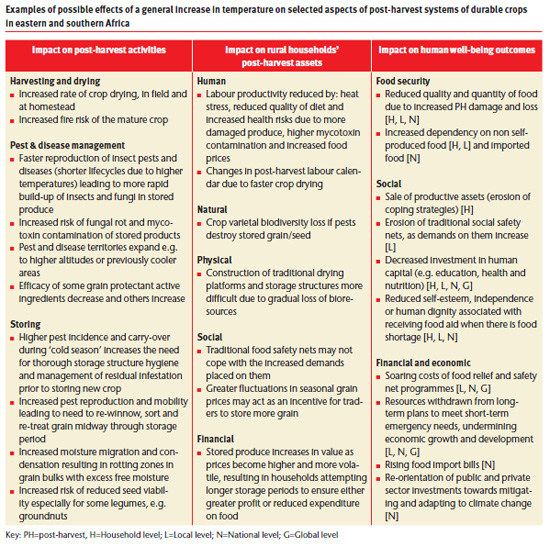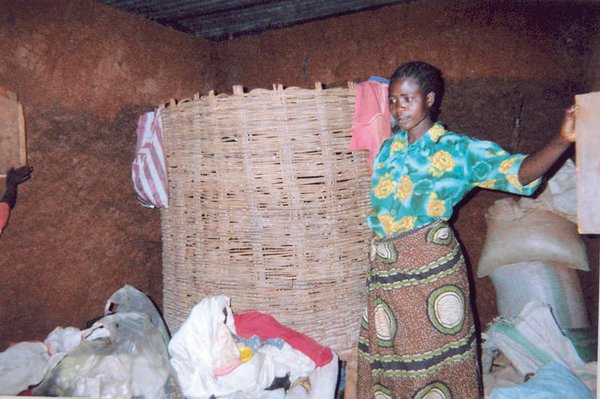 Download this article in magazine layout
Download this article in magazine layout
- Share this article
- Subscribe to our newsletter
Post-harvest agriculture in a changing climate
Global warming is bringing complex and diverse climate change and impacts in sub-Saharan Africa (SSA; see Box). The economies of, and livelihoods in, many SSA countries are based on smallholder rain-fed agriculture. Whilst agricultural production in many higher-latitude countries is initially likely to benefit from moderate global warming, in tropical regions where crops are already close to critical environmental thresholds, crop yields and areas suitable for growing them will decline. Studies suggest that by 2080, countries such as Tanzania and Zimbabwe could lose up to 30 per cent of their 1990 cereal yields (Parry et al., 2004). Declining yields are likely to trigger further agricultural expansion, deforestation, green house gas (GHG) emissions and subsequently global warming.
Anticipated climatic changes in sub-Saharan Africa (SSA)
Projections suggest that by the year 2030, temperatures across SSA will have risen by about 1 °C compared to those of 1980–1999 (Lobell et al., 2008). Additionally, southern Africa is likely to experience a 10 per cent rainfall decrease and more frequent drought, while East Africa is expected to see rainfall increases in the north and decreases in the south. Increasing occurrences of high rainfall events and flooding are also anticipated (Christensen et al., 2007).
However, climatic change is just one stressor among many complex, interacting and dynamic factors that influence smallholder farming households in SSA. Other factors include: population growth, urbanisation, education, health, especially HIV and Aids, financial service provision and market changes. Vulnerability to climate change and adaptive capacity is determined by a similarly wide combination of interacting socio-ecological factors.
Post-harvest systems
Post-harvest systems are diverse, reflecting the varied nature of the people, place, focal crop or product and the different activity stages involved. Post-harvest systems are influenced by the activities and interactions of many different players. An agricultural innovation systems perspective provides an analytical framework with which to examine technological and institutional change in post-harvest systems; identifying the players and factors affecting demand for, and use of, existing and new post-harvest and climate change knowledge.
Food security and post-harvest agriculture
Most cereals consumed in SSA are produced by smallholders, with commercial imports accounting for roughly 25 per cent of the cereal consumption in the region and food aid for about 5 per cent. However, post-harvest losses of cereal grains in SSA are estimated to reach nearly four billion US dollars annually, which in cash terms, equates to wasting 15 per cent of SSA’s annual cereal production (World Bank et al., 2011). As yields are expected to decline and the value of harvested and traded commodities subsequently increases, the cost of not reducing these post-harvest losses also increases. Furthermore, in this scenario, where extra food has to be produced to compensate for losses due to ineffective post-harvest management, this is a waste of valuable resources. With Africa’s population projected to double to two billion people by 2050, and living standards and populations elsewhere also increasing, estimates suggest that global food production will need to increase by 70 per cent. Under a scenario of continuing high population growth and regional disparities in income, an additional 550 million people globally could be at risk of climate-related hunger by 2080, with 65 per cent of this increase occurring in Africa (Parry et al., 2009). There are key post-harvest elements of food availability, stability, access and utilisation. For example, maintaining high quality and sufficient stocks of stored grain enables a household (or a nation) to provide itself with a nutritional and safe supply of food until the next harvest. Given that the market value of grain typically increases up until the next harvest, grain stocks also provide a market-linked asset, part of which can be sold if needed to cover income shocks or emergencies.
Post-harvest impacts of climate change
Five key climate change trends affecting different parts of SSA were identified:
- a general increase in temperature;
- more frequent occurrence of dry spells and droughts;
- more frequent occurrence of high winds, storms, heavy precipitation events and flooding;
- more erratic rainfall;
- increased rainfall amount and/or duration.
These climate change trends are unlikely to occur in isolation from each other or other drivers of change.
The potential impacts of each of these climate change trends on the different post-harvest activities, assets (human, natural, physical, social and financial) and human well-being outcomes (food security, social, financial and economic) were identified. An example of this analysis for the potential impacts of a general increase in temperature on the drying, pest management and storage activity stages, and selected assets and well-being outcomes is given in the Table.

Post-harvest agricultural adaptation to climate change
Despite the significant uncertainty regarding the scale, type and interactions of climate change impacts, mitigation and adaptation activities are needed if we are to avoid the most serious consequences of global warming. After establishing the potential impacts, we identified a range of climate-smart post-harvest agricultural adaptation opportunities (see Box).
Climate-smart post-harvest agricultural adaptation opportunities
• Growing and/or storing crops and varieties which are less susceptible to post-harvest pest attack;
• Prompt harvesting;
• Adequate and protected drying;
• Maintenance of the physical storage structures;
• Careful store cleaning and hygiene;
• Accurate estimation of food stock requirements;
• Protection and monitoring of grain to be stored for more than three months;
• Use of low GHG emission food preparation methods;
• Understanding and application of basic food safety principles;
• Increasing farmer access to market information and transport options;
• Use of early warning seasonal forecasts to project how the climatic conditions might impact on food storage or marketing strategies;
• Use of more water, energy and resource efficient processing, packaging and transport operations;
• Ensuring plant breeders evaluate post-harvest as well as pre-harvest crop characteristics; and
• Helping farmers to learn from others’ and their own experiments.
Smallholder farming households across SSA are well aware of the importance of good food storage, and perceive their ability to store food as a strength influencing their capacity to adapt to climate change and variability. While the review highlighted just how many climate-smart post-harvest adaptation opportunities are already known and even practised by some farmers, it also illuminated the scale and problems faced in getting these ‘no-regrets’ post-harvest practices into wider social and economic use.
Factors influencing the adaptive capacity of post-harvest systems
The successful application of post-harvest technical solutions is dependent on a well-functioning agricultural innovation system, which through experiential co-learning practice can overcome institutional constraints which are preventing the scaling out and up of post-harvest products and processes. However, across SSA, there is a desperate lack of skilled post-harvest service providers at all levels. As well as the post-harvest skills, understanding is needed of the futility of ‘one-size-fits-all’ solutions and the importance of responsive client-focused services which support experiential learning processes to build the adaptive capacity of smallholder farmers to deal with increasingly uncertain futures. Post-harvest aspects are under-represented in most agricultural curricula. Peer learning is stifled by the very private nature of activities such as grain storage practices which usually occur behind closed doors. Additional knowledge gaps exist as regards understanding post-harvest gender roles. The lack of investment in post-harvest compared to pre-harvest agricultural development, research and policy activities only accentuates the problems of getting post-harvest knowledge into use. Perhaps climate change impacts and shocks will gradually draw attention to the crucial role that post-harvest agricultural adaptation can play in strengthening livelihoods, attracting support and developing skills for getting the many ‘no-regrets’ climate-smart post-harvest adaptation opportunities into use at scale.
Tanya Stathers, Richard Lamboll
Natural Resources Institute (NRI) University of Greenwich, United Kingdom
TStathers@aol.com
Brighton M. Mvumi
University of Zimbabwe
References /Sources for further reading
Christensen et al. 2007. Regional climate projections. Climate Change 2007: The Physical Science Basis. WGI 4AR IPCC.
Lobell et al. 2008. Prioritizing climate change adaptation needs for food security in 2030. Science, 319, 607-610.
Parry et al. 2004. Effects of climate change on global food production under SRES emissions and socio-economic scenarios. Global Environmental Change, 14, 53-67.
Parry et al. 2009. Climate change and hunger: responding to the challenge. WFP.
World Bank et al. 2011. Missing Food: the case of postharvest grain losses in sub-Saharan Africa.





Add a comment
Be the First to Comment